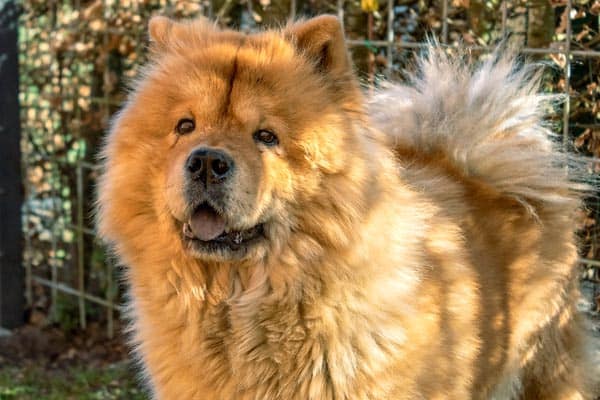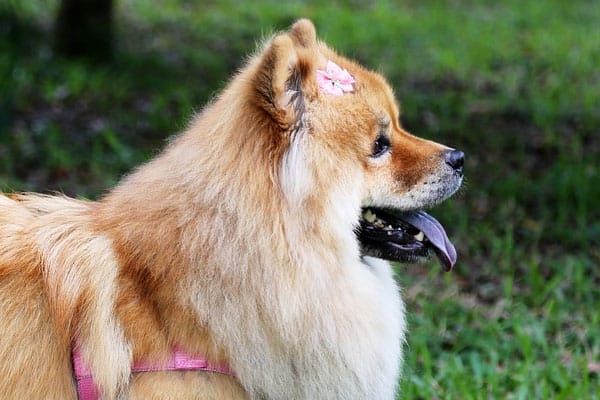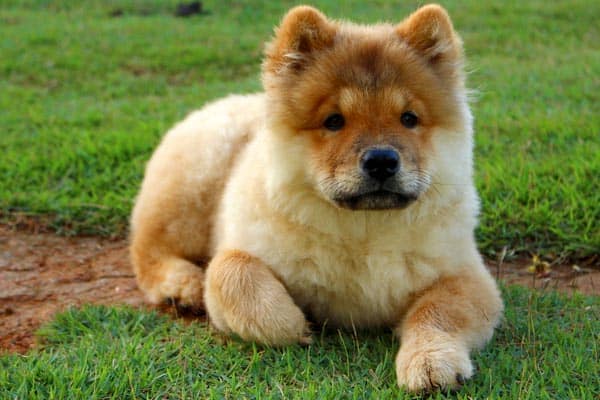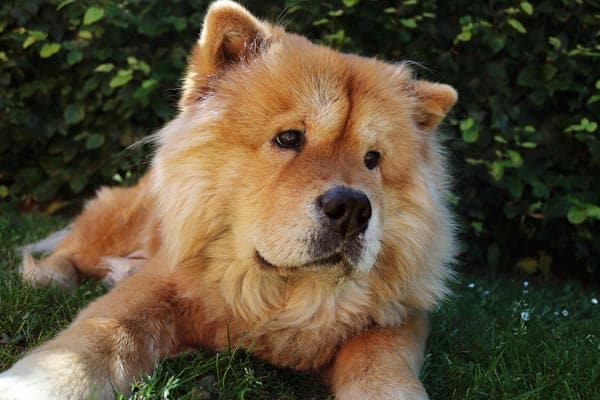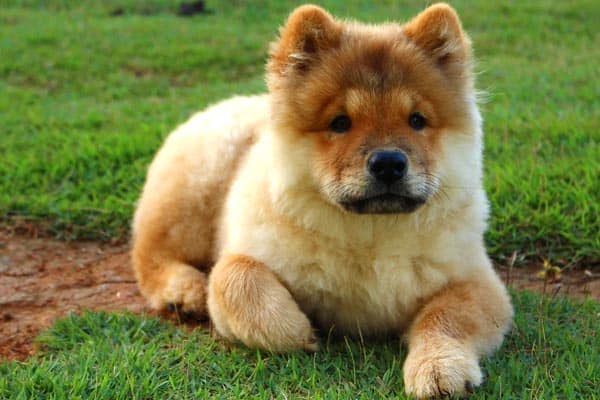Are Chow Chows Aggressive? Managing the Primitive Dog’s Signature Disposition
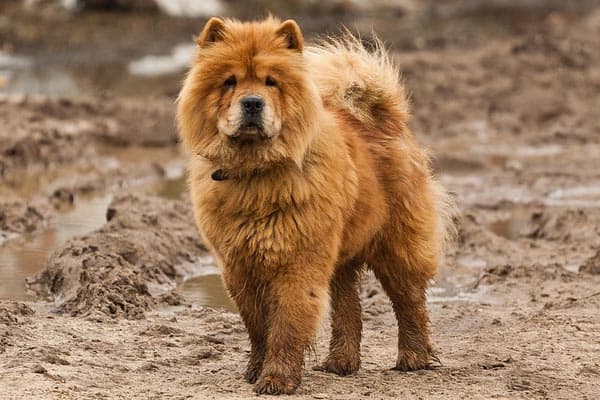
When you see someone walking a Chow Chow down the road, what is your first thought?
“Ah, what a beautiful dog,” or “How cute!” might be two phrases that spring to mind. Perhaps Chow’s reputation for aggression precedes any impressions about the dog’s regal appearance.
If you own a Chow, what is your experience with the breed?
Are Chow Chows aggressive?
The Chow Chow is by nature an aggressive dog breed. Fiercely protective of its territory and suspicious of strangers, the Chow makes an intimidating adversary despite its medium size. Not only can Chows be defensive against human intruders, but they tend to be less than tolerant of other dogs.
Like with any breed, training and socialization are the means to taking the edge off aggressive tendencies in the Chow Chow.
Aggression does not have to involve an attack.
Dangerous behaviors by dogs can indicate they are about to attack but do not always involve a bite. These behaviors are still antisocial and can result in trauma to the target.
- Barking
- Charging
- Lungeing
- Growling
- Snarling
- Snapping
How does history affect Chow’s aggression?
Chow Chows are one of the earliest branches of the domestic dog from the wolf. In existence 2,000 to 3,000 years ago, Chows retain their primitive temperament even into the 21st century.
This means breeders have not been able to modify a Chow’s instincts or motivations over the centuries.
You may wonder what a Chow’s instincts are. If you think of a branch very close to the root, the wolf, you can count on certain ancestral motivations.
- Predatory drive
- Territorial instincts
- Protective of the pack
- Reproduction
- Guarding resources
- Detecting weakness
- Challenging leadership and jockeying for position within the pack
Now, think of Chow’s uses in ancient times.
- Guarding livestock and farms
- Tang Dynasty (618 to 907 AD) – hunting and guarding palaces
- Monasteries – guarding
- Food animals – used for their coats and meat; probably affected body type and coat quality more than temperament but did not contribute to the same type of human-animal bond seen with other breeds
- Herding
- Pulling sleds
Ancient people did not try to change the Chow Chow but rather selected qualities that matched their agendas. They used protective and territorial urges to help guard their families, property, and livestock.
Resource and pack protectiveness added even more to the Chow’s utility in guarding. Breeding placed a lot of emphasis on ferocity.
Prey drive was useful for driving livestock, but more importantly in the Chow, in aiding on hunts. Other traits, such as challenging authority and exploitation of the weak-willed remained intact within the breed.
Are Chow Chows aggressive with children and other pets?
Chows are aggressive with unfamiliar children in the same way they are hostile towards strangers.
However, in the case of small children, Chows may also see them as prey. Therefore, a Chow may be more likely to bite a kid because of the child’s behavior.
- High-pitched squealing and yelling
- Running – uneven, erratic gait and movements
- Staring a dog in the eyes
- Sticking their face near a dog’s
- Flailing the arms
- Overstimulating a dog
A Chow can easily overwhelm a child because of its size and strength. A toddler’s face and neck are within easy reach of the Chow’s jaws. Young children are frequently off-balance, and a Chow can knock them over with little effort.
Even your children bear constant watching because they can unintentionally provoke an attack. Do not count on your Chow Chow to have much tolerance for childish playful antics.
Moreover, your Chow is prone to forming only one bond with one person in the family. That person will most certainly be an authority figure, so your dog’s loyalty will not necessarily extend to your children or spouse.
Chows are also not ideal choices for homes with multiple pets. Small animals, like cats and small-breed dogs, can become the targets of predatory behavior.
Chows are not particularly accepting of other dogs, especially those of the same gender as themselves.
You can attribute this to Chow’s tendency to be territorial and protective as well as some reproductive instincts.
Neutering may help, but it likely will not alleviate all your dog’s aggression. If not socialized, your Chow will be perpetually suspicious of everyone, humans and other dogs alike.
Can you train a Chow not to be aggressive?
Experts emphasize the difficulty in training a Chow and trying to modify the ingrained behavior of a primitive breed.
However, they also will point out that the Chow is straightforward and transparent. Professional trainers feel the Chow reacts more predictably than many other breeds.
If you research their history, Chows had a versatile use, but many of their duties centered around serving as catch dogs for livestock or defending property.
They were not developed as pets that greeted visitors of the royal temples of China. It is an uphill battle to modify a Chow’s hostile behavior towards strangers, but you should not write off training.
Many owners give up training or socializing Chow Chows before they even start. It is a challenge to train any dog in the Spitz family but not impossible.
Training your Chow not to bite should begin as with any other dog during early puppyhood. Socialization should begin at a very young age as well.
According to VCA Hospitals, puppies are the most receptive to the effects of socialization between six and twelve weeks.
Hopefully, your breeder handled your puppy a ton before you acquired her, but your job begins in earnest as soon as she arrives home.
Any time you decide to own a guard-type dog, you need to spend even more time socializing it than you would other breeds.
Many owners feel socialization is counterintuitive in a dog they intend to use to protect themselves, their families, and perhaps their property.
However, guard dogs already have a high propensity to be aggressive towards people. They need to learn discrimination and impulse control so they do not become liabilities.
When you socialize your dog, his increasing familiarity with different people and situations will help him accurately distinguish between a threatening person and normal human behaviors.
Most guard dogs are designed to attack as a last resort and after plenty of warning through barking, growling, and other posturing behaviors.
When you socialize your dog, you desensitize him to various stimuli that occur in the environment and those that are secondary to visitors. This helps prevent unprovoked attacks and reinforces his purpose as the last line of defense.
It is important to note that most dog owners want and need a guard dog which is much different than an attack animal.
Your Chow puppy also warrants more training than most because of its membership in the Spitz family.
Although highly intelligent and resourceful, Spitz types tend to be dominant, independent, and notoriously difficult to train.
Most could not care less about pleasing their owners, and Chow Chows are no exception. To give you a visual idea of the Spitz family, a few examples follow.
- Pomeranian
- Akita
- Siberian Husky
- Alaskan Malamute
- Norwegian Elkhound
Chow Chows, like any dog, respond negatively to the use of abusive, forceful, or harsh training methods. Where other breeds may shrink and cower, Chows may become aggressive and turn on their owners in the face of adversarial training methods.
Chows require patience, perseverance, and a lot of repetition. They also need to see you as an authority figure, or they will not take direction from you.
You should engage your Chow in multiple training sessions a day rather than try to focus your efforts on one marathon session.
If your Chow Chow shows signs of boredom, frustration, or impatience, move on to another exercise or change up your methods.
Use plenty of rewards to keep your Chow in a more cooperative mood and make it worth her while. Remember, she is not terribly interested in pleasing you. You obtain your goals through high-value treats or other incentives and mutual respect.
Is Chow aggression different than in other guard dogs?
Primitive breeds like the Chow Chow need socialization because their nature might be antisocial. You are likely to notice several differences between Chow Chow aggression and other breeds.
- A Chow may give little if any warning before an attack – what warning a Chow Chow gives is likely to be directly before an attack and minimal compared to a German Shepherd or Rottweiler
- Chows are independent and may not respond to commands to stop an attack
- Chows were bred to be fierce – when they attack, they might be more intent on maximum damage compared to other breeds
- Poor peripheral vision – when you look at a Chow’s face you can see structural characteristics that give the eyes an unusual position, challenging the dog’s ability to see to the sides; you can easily tread into a Chow’s blind spots, triggering a startle reaction and attack
- ATT test below average – standardized canine temperament test
This Chow Chow shows the minimal warning and even mixed signals it can give before an attack.
If you know the dog, it is perhaps a predictable ritual. But note the vigorously wagging tail, lackluster barking, and even a play bow thrown in. But he is also ripping into the fence. This
Chow is displaying dog aggression, but his language is probably similar when facing a strange person.
Why does Chow score low on an ATT test?
The American Temperament Test Society found its calling with the advent of breed-specific bans directed against certain dogs and their owners.
Many forms of legislation allow insurance companies, renters, airlines, and even locales to restrict or ban the ownership of any breeds they deem vicious or destructive.
Temperament testing often dispels some preconceived notions. ATT tests do not target viciousness or aggression but rather a dog’s ability to interact with people in different simulated situations. A dog can fail a test based on three character defects.
- Pronounced avoidance – the dog does everything in its power to avoid physical proximity and eye contact; the dog’s movements come just shy of fleeing
- Panic – a dog startles to the point of panic and does not recover; signs of panic are trembling, wide eyes, heavy and distressing panting, trying to flee
- Unprovoked aggression – dog misreads a friendly or neutral situation and threatens or attacks or is vicious and attacks indiscriminately
This Chow is exercising avoidance rather than attacking. He is also giving more warning of an attack than many Chow Chows would.
ATT statistics do not specify why dogs fail, so it is unclear how many of the 29% of Chows that did not pass reacted with excessive shyness rather than aggressively.
Based on the breed’s tendencies, you could speculate that most were likely aggressive rather than fearful. However, fearful dogs can also react with aggression.
A Chow’s ATT score measures its temperamental stability and capacity to distinguish between a friendly encounter and a situation requiring a protective reaction.
It is below average across a sampling of 28 breeds (71.8% pass for Chow compared to 78.8% mean pass rate overall). More specifically, you can measure Chows against what you typically think of as guard dogs.
- Doberman Pinscher = 79.1% pass rate
- Rottweiler = 81.3% pass rate
- German Shepherd = 85.3% pass rate
There are not many dogs that score lower than the Chow, but with a pass rate of more than two-thirds, there is no indication that the breed is inherently vicious or untrainable.
